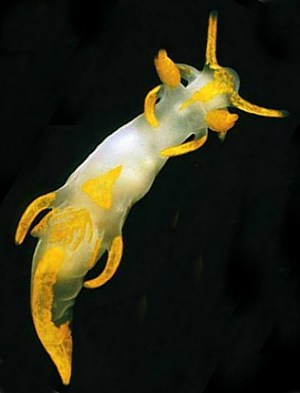
Trapania maculata
Haefelfinger, 1960
Order: NUDIBRANCHIA
Suborder: DORIDINA
Superfamily: ANADORIDOIDEA
Family: Goniodorididae
DISTRIBUTION
Western Mediterranean to British Isles.
PHOTO
Portland Bill, Dorset, England. June 1974. Photo: Tom Thompson.
Reference:
• Brown, G.H. & Picton, B.E. 1976. Trapania maculata Haefelfinger, a doridacean nudibranch new to the British fauna. Journal of Conchology, Lond., 29: 63-65.
• Haefelfinger, H-R. (1960) Neue und wenig bekannte Opisthobranchier der Gattungen Trapania und Caloria aus der Bucht von Villefranche-sur-mer (A.-M.). Revue Suisse de Zoologie, 67(2): 226-238.
Rudman, W.B., 2001 (February 10) Trapania maculata Haefelfinger, 1960. [In] Sea Slug Forum. Australian Museum, Sydney. Available from http://www.seaslugforum.net/find/trapmacu
Related messages
Re: Trapania maculata with eggs
February 26, 2009
From: Dominique Horst
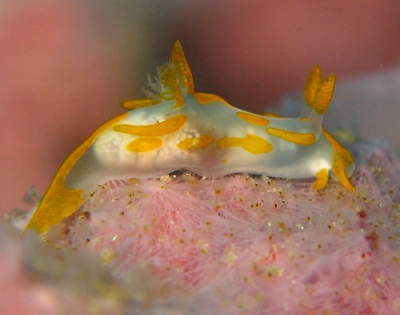
Concerning message #22277:
Hi Bill,
Two more pictures to show the visible egg mass from different point of view.
Not sure these help to be sure that the egg ribbon is pre-formed in the slug before laying it down.
Locality: Cannes, 23 m, France, Mediterranean sea, 21 February 2009. Length: 7 mm. Photographer: Dominique Horst.
Kind regards,
Dom.
dominique.horst@wanadoo.fr
Horst, D., 2009 (Feb 26) Re: Trapania maculata with eggs. [Message in] Sea Slug Forum. Australian Museum, Sydney. Available from http://www.seaslugforum.net/find/22287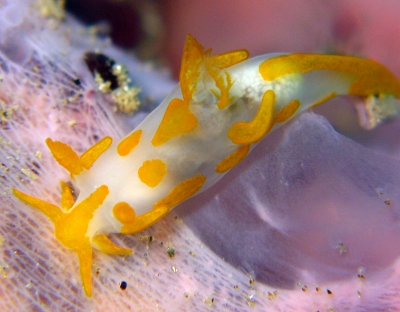
Dear Dom,
I think these photos clarify the situation quite well. Although from the right side of the animal the eggs do seem to be coiled in an ribbon-like tube, the photo from the left side shows the eggs scattered more randomly. So I think we can say that their apparent arrangement in a coiled egg ribbon is just an illusion. To further explain the position of the ovotestis - which makes the eggs and sperm - have a look at your photos in an earlier message [# 22088]. The dark brown-black organ which fills the back half of the body is the digestive gland, which is unique to molluscs, and as its name suggests, is involved with digesting the food, absorbing the nutrients into the bloodstream, and in excreting the waste products. In most dorids the ovotestis forms a layer over the top half of the digestive gland and in some cases, such as Trapania, also extends into a lump behind the digestive gland. We can see this very clearly in your two photos.
Best wishes,
Bill Rudman
Trapania maculata with eggs
February 24, 2009
From: Dominique Horst
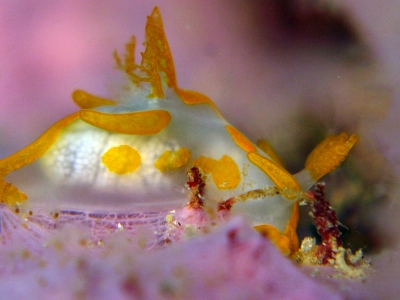
Hi Bill,
This Trapania maculata is very transparent and it seems to show the egg-mass inside ?
Locality: Cannes, 23 m, France, Mediterranean sea, 21 February 2009. Length: 7 mm. Photographer: Dominique Horst.
Kind regards,
Dom.
dominique.horst@wanadoo.fr
Horst, D., 2009 (Feb 24) Trapania maculata with eggs. [Message in] Sea Slug Forum. Australian Museum, Sydney. Available from http://www.seaslugforum.net/find/22277Dear Dom.,
We haven't that much information on the eggs of Trapania, but the photo we have of the egg mass of T. benni [message #5992] suggest the white spots in your photo could be egg-sized, and the way they are arranged certainly looks like the egg-ribbon after it is deposited. However the ovo-testis - where the eggs and sperm are produced forms a thin layer over the digestive gland just where the white spots are in your photo. Usually the eggs travel down to the female genital opening in a single string and are fertilised on the way. They are not surrounded in the mucous jelly and arranged into the tubular cluster of eggs until they are about to be deposited. Either your animal is doing something very strange or what we can see is just an illusion. Perhaps what we can see are the eggs in the ovotestis and the apparent clear lines between them, which give the impression we are looking at a coiled tube of eggs, are blood vessels in the ovotestis.
Its an interesting photo. Any other interpretations would be welcome
Best wishes,
Bill Rudman
Re: Feeding Trapania maculata from the Mediterranean
December 16, 2008
From: Dominique Horst
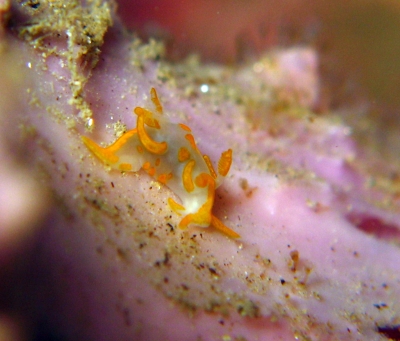
Concerning message #22088:
Hi Bill,
Here is one more pic of Trapania maculata feeding, in which the entoproct is more visible.
It is so small that I simply did not see them before you pointed them out.
I think I will need glasses for the future ...
Locality: Cannes, 28 m, France, Mediterranean sea, 29 November 2008. Length: 5 mm. Photographer: Dominique Horst.
Many thanks and kind regards,
Dom
dominique.horst@wanadoo.fr
Horst, D., 2008 (Dec 16) Re: Feeding Trapania maculata from the Mediterranean. [Message in] Sea Slug Forum. Australian Museum, Sydney. Available from http://www.seaslugforum.net/find/22099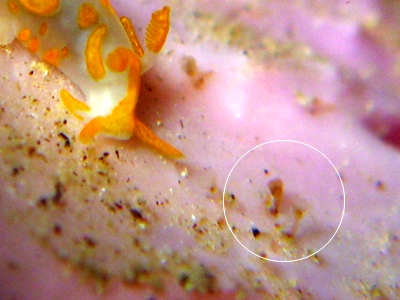
Dear Dom,
Now you have seen the size to look for I am sure you will spot them without glasses. However if you are lucky and the kamptozoa are more plentiful, a sure sign is a 'furry' covering over the sponge. Bernard Picton's photos [message #3767] show it very well. Another good indication in many cases are the little brown spots which can be seem in the photo on the kamptozoa Fact Sheet.
Best wishes,
Bill Rudman
Re: Feeding Trapania maculata from the Mediterranean
December 16, 2008
From: Juan Lucas Cervera
Concerning message #22088:
Dear Bill and Dominique,
Two years ago, Luis Sanchez Tocino and I published a short note about the diet of Trapania maculata and T. hispalensis from southern Spain.
-
L. Sánchez-Tocino and J. L. Cervera. 2006. Primeros datos sobre la dieta de Trapania maculata Haefelfinger, 1960 y T. hispalensis Cervera y García-Gómez, 1989 (Mollusca: Nudibranchia). Zoologia Baetica, 17: 85-89.
Regards.
Lucas.
lucas.cervera@uca.es
Cervera, J.L., 2008 (Dec 16) Re: Feeding Trapania maculata from the Mediterranean. [Message in] Sea Slug Forum. Australian Museum, Sydney. Available from http://www.seaslugforum.net/find/22098Dear Lucas,
Thanks for letting us know. I was pretty sure there was a recent paper on feeding in T. maculata but I have just converted by bibilographic database to a new program and am still having a few 'teething problems'.
For those of you unfamiliar with the paper, Luis and Lucas report both T. maculata and T. hispalensis feeding on a kamptozoan of the genus Loxosomella which was living on sponges of the genera Dysidea and Sarcostragus.
Best wishes,
Bill Rudman
Feeding Trapania maculata from the Mediterranean
December 12, 2008
From: Dominique Horst
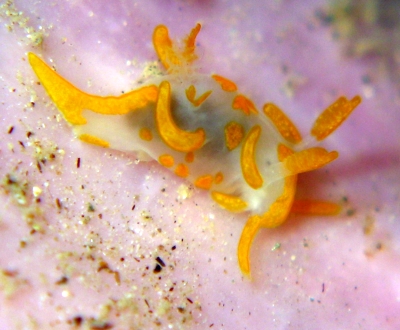
Hello Bill,
I've found Trapania maculata for the first time. It seems that it is feeding on the sponge Dysidea (probably D. variabilis). Do they feed exclusively on entoprocts? In the picture, the dark part inside should be entoprocts ?
But does it means they are unable to feed on any sponge?
Locality: Cannes, 28 m, France, Mediterranean sea, 29 November 2008. Length: 5 mm. Photographer: Dominique Horst.
Many thanks and regards,
Dom.
dominique.horst@wanadoo.fr
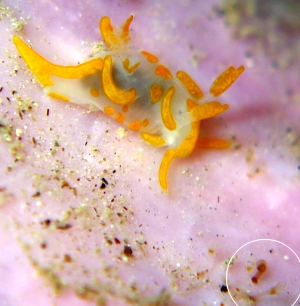
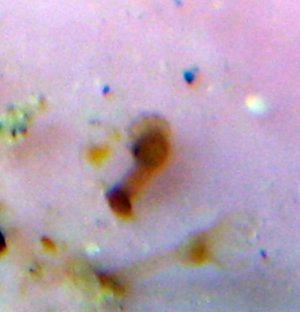
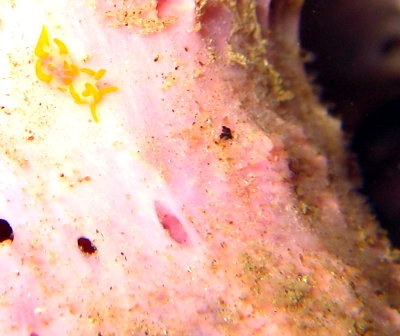
Dear Dom,
As I have discussed elsewhere on the Forum, species of Trapania were for a long time considered to be sponge feeders, because they were usually found on certain sponges. However if we look at their radular teeth, we find that they are quite different from the teeth of other sponge feeders. We now have good evidence from photographs on the Forum that many species of Trapania feed on species of kamptozoa [entoprocts] which grow on these sponges. I have looked carefully at your photos and found two kamptozoan animals in the bottom right corner of one. I have included a close-up. Also, in the photo alongside my comments, I can see a 'furry' covering over the right edge of the sponge colony. I wouldn't be surprised if that was an aggregation of kamptozoans as well. This is the first direct evidence on the Forum of T. maculata associating with kamptozoans.
You can sometimes see one or two black spots inside the body of the kamptozoan individuals. These spots are the waste products inside the gut of the kamptozoans - in fact it is often the only clue I can see in photos that the blurry cover over some sponges is in fact kamptozoans. Concerning the black mass in the Trapania, that is the colour of the nudibranch's digestive gland. In most molluscs it is a dark brown to black colour. The digestive gland is a unique molluscan organ which produces digestive enzymes, absorbs and digests food, and excretes wastes.
As to whether any species of Trapania eats sponge. My personal feeling is that I am sure they don't, but since we don't have evidence for all species all I can say is that there is no direct evidence that they do and a lot to say they feed on kamptozoans that live on sponges. The more we investigate, the more evidence is accumulating to show that nudibranchs are often very specialised feeders, some species feeding on only one food species. It also appears that in most cases, food choice is linked to phylogenetic relationships - that is closely related species will eat the same or similar food items. We find similar food specialisation in many invertebrate groups. For example, the caterpillar larvae of many butterflies and moths will only feed on only one or two species of plants.
Best wishes,
Bill Rudman
Nudibranchs from the Aegean sea
November 20, 2002
From: Haluk Akbatur
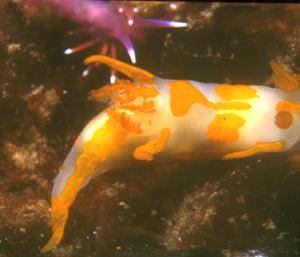
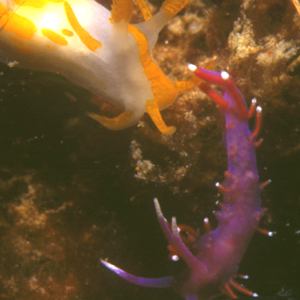
Dear Bill,
Thanks for your Umbraculum comments. I have these slides taken in the Aegean Sea in 1999. As I know very little basic information about these species and their feeding habits, I have some questions. First of all what are these two nudibranchs?. I think the violet one is Flabellina pedata or F. ischitana which has autotomised its cerata or been eaten by the yellow species??
Best wishes,
Haluk
lasergoz@ttnet.net.tr
Akbatu, H., 2002 (Nov 20) Nudibranchs from the Aegean sea. [Message in] Sea Slug Forum. Australian Museum, Sydney. Available from http://www.seaslugforum.net/find/8425Dear Haluk,
The violet nudibranch is most probably Flabellina pedata, and as you say its cerata have either been autotomised or damaged in some way. However the orange-spotted animal is not to blame. This is Trapania maculata which belongs to a group of nudibranchs that feed on entoprocts, small stalked animals, which previously used to be mistaken for bryozoans.
Best wishes,
Bill Rudman
Trapania maculata from the Mediterranean
July 30, 2002
From: Marina Poddubetskaia
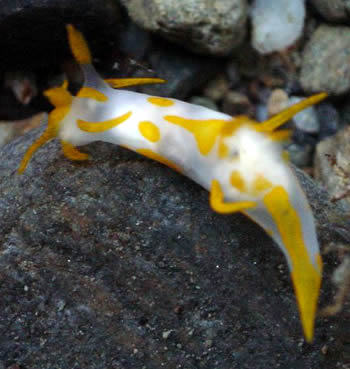
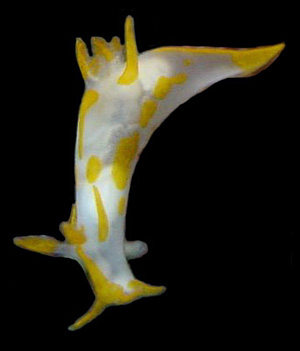
Dear Bill,
Here are some photos of Trapania maculata.
Date: July 02, 2002
Location: Cerbere, France
Site: Cap Negre
Size: 15-20mm
Photos: Marina Poddubetskaia - Nembro website
Best wishes,
Marina.
nembro@nembro.info
Poddubetskaia, M., 2002 (Jul 30) Trapania maculata from the Mediterranean. [Message in] Sea Slug Forum. Australian Museum, Sydney. Available from http://www.seaslugforum.net/find/7600Thanks Marina,
Bill Rudman
Trapania maculata from Turkey
September 26, 2001
From: Baki Yokes
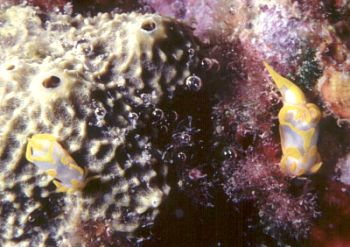
Dear Bill,
If these are Trapania maculata, then they are common in shallow waters of Northern Aegean islands. It is possible to see them even while snorkelling. They are usually found on rocky surfaces, and often in pairs.
Place: Bozcaada, Turkey
Divesite: Ayana
Depth: 1m
Size: 1cm
Date: August, 1996
Photo: Baki Yokes
Baki
bakiyokes@turk.net
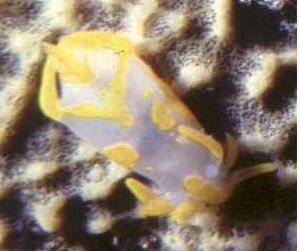
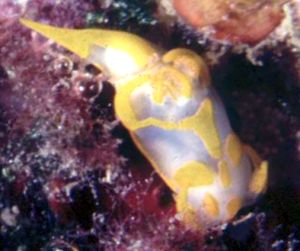
Dear Baki,
It certainly looks like Trapania maculata. Interesting to see it on a sponge colony - Ircinia sp. perhaps? - which is one of its usual habitats. As you will see elsewhere on the Forum, these animals feed on entoprocts.
I am not sure if this species has been recorded this far east in the Mediterranean before. Hopefully our colleagues can let me know whether this, and your other contributions, are new records for the northeastern Mediterranean.
Best wishes,
Bill Rudman
Re: origin of Trapania
May 1, 2001
From: Bernard Picton
Hi Bill,
In your comment on the origin of Trapania you don't mention the origin of Drepania, but I checked this out (the name is used for hook-tip moths and is itself a junior synonym of Drepana) - I think it comes from the Greek drepane which is a sickle and presumably refers to the sickle-shaped processes alongside the rhinophores in Trapania (as well as the hooked tips to the moth's wings).
Bernard
bernard.picton.um@nics.gov.uk
Picton, B., 2001 (May 1) Re: origin of Trapania. [Message in] Sea Slug Forum. Australian Museum, Sydney. Available from http://www.seaslugforum.net/find/4271Dear Bernard,
I must admit I gave up when I realised it was a replacement name, but since Trapania is based on Drepania I guess we are allowed to say it also originates from the Greek 'drepane'. Thanks for an elegant solution to an old puzzle.
Cheers,
Bill Rudman
Re: origin of Trapania
April 29, 2001
From: Miquel Pontes
Hi Bill,
Thanks a lot for posting my question on the Forum. I have read your answer on the Forum and they agree with kind comments Bernard Picton sent me on the subject more or less at the same time.
Best wishes
Miquel Pontes
mpontes@marenostrum.org
Pontes, M., 2001 (Apr 29) Re: origin of Trapania. [Message in] Sea Slug Forum. Australian Museum, Sydney. Available from http://www.seaslugforum.net/find/4257Trapania maculata from Spain
April 26, 2001
From: Miquel Pontes
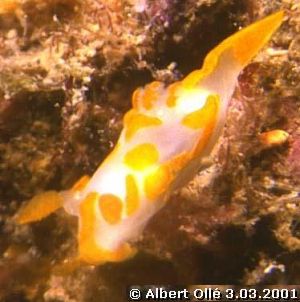
Hi Bill,
We recently found a Trapania maculata, a species that we have not seen before in over 200 dives in the Costa Brava of Spain. Of course we may have not looking the proper place to find it.... Anyway, despite the identification seems to be clear, we would like to know the etymology of the genus name "Trapania". Our guess is that it is related to the Italian town of Trapani but we're not sure of this point. Maybe you can help us on this.
By the way, All three pictures were shot by Albert Ollé at a depth of 11,5 meters in a place called Cala Rovellada, in the village of Colera, near the Mediterranean Spanish-French border. More details (in Spanish) at the following URL: http://marenostrum.org/opistobranquios/tmaculata
Thank you
Miquel Pontes
mpontes@marenostrum.org
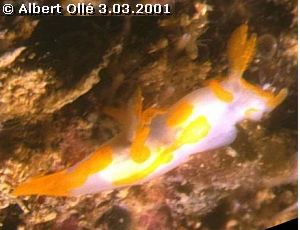
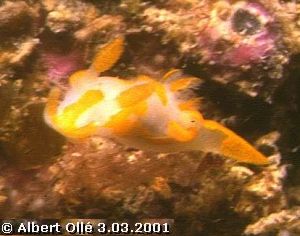
Dear Miquel,
Thanks for the photos. It is certainly nice to find something for the first time. Concerning the origin of the word Trapania. The name was introduced by Pruvot-Fol (June, 1931) as a replacement name for Drepania Lafont, 1874 which was already in use for an insect. By strange coincidence Macfarland published another replacement name (Drepanida) only a month later.
When I was in Sicily for the Menfi Workshop I wondered whether the Sicilian town of Trapani was the origin of the name Trapania, but I could find no connection. The type species of Drepania, and its replacment names, is Trapania fusca. It was originally found at Arcachon in France, so if there is a connection with Sicily I would be interested in hearing of it. Unfortunately Pruvot-Fol does not give a reason for the new name Trapania so I can only assume it was made up to sound similar to Drepania.
• Rudman, W.B. (1987) The genus Trapania (Nudibranchia: Goniodorididae) in the Indo-West Pacific. Journal of Molluscan Studies, 53: 189-212.
Best wishes,
Bill Rudman
Trapania maculata from England
February 12, 2001
From: Bernard Picton

Just to complete the set, this is a close-up of Trapania maculata, the first specimen found in the British Isles.
Details: Portland Bill, Dorset. June 1974. Photographed by Tom Thompson.
• Brown, G.H. & Picton, B.E. 1976. Trapania maculata Haefelfinger, a
doridacean nudibranch new to the British fauna. Journal of Conchology, Lond., 29: 63-65
Bernard
bernard.picton.um@nics.gov.uk
Picton, B., 2001 (Feb 12) Trapania maculata from England. [Message in] Sea Slug Forum. Australian Museum, Sydney. Available from http://www.seaslugforum.net/find/3769Dear Bernard,
Thanks for the photo. It's nice to have one of Tom's photos on the Forum. I often think that if he was still around he would have embraced the world wide web with his abundant enthusiasm. All the Forum needs now is some more of the many species of Trapania reported from the Mediterranean and adjacent waters,
Best wishes,
Bill Rudman
